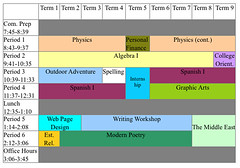June 3, 2010
Adhocracy
Dr. Michael Riendeau, Assistant Headmaster for Academic Affairs
Eagle Hill School has long articulated its commitment to an organizational philosophy described as adhocracy—a play on bureaucracy—that privileges innovation over standardization. Tom Skrtic, the longtime chair of the department of special education at the University of Kansas, describes adhocracies as “problem-solving organizations that invent new practices for work that is so ambiguous and uncertain that the knowledge and skills for doing it are completely unknown.” It might seem a stretch to think of schools as doing work for which the knowledge and skills are completely unknown. I imagine teachers immediately protesting, “But we know how to teach reading, science, history” and so forth. If we at Eagle Hill believed that what we teach are subjects like reading and mathematics, we might join this protest. If instead, however, we begin to think of our work as with students rather than subject matter, the uncertainty in Skrtic’s formulation becomes clear: how to teach Harry or Sadie to read is a different sort of project than teaching reading. As a teacher, I cannot know—before I meet a student or a particular group of students—which approaches will work, what ideas will resonate, or even (especially!) what goals we might want to achieve together. Of course, I do know about reading or painting or chemistry, about national and institutional interests, and about pedagogy—in the abstract, and that knowledge provides a starting point. Too often in our educational institutions, though, we see that knowledge as the endpoint, and we are unable to understand the needs of actual students, real—and complicated—individuals.

Our most recent effort to recognize and respond to the needs of individuals is a novel curriculum design. After several years of study, this year we implemented a curriculum that shifts consideration further in the direction of individual needs and interests. The premise is simple: make decisions about scheduling at the section or student level rather than at the course level. In practical terms, this means that some students might study writing for one hour each day for six months while others study writing two hours each day for two months. To provide a mechanism for this, we’ve instituted a school year that is divided into nine terms, increasing the granularity and flexibility with which we can arrange the meeting times for any course section. Most students complete Algebra I in eight terms, but a section that needs a ninth term is scheduled for nine terms. Some students are inclined to devote a full year to studying technical theater, and some are inclined to explore this for only a term or two. By thinking first about students rather than subjects, we’re realizing our commitment to adhocracy a little further.